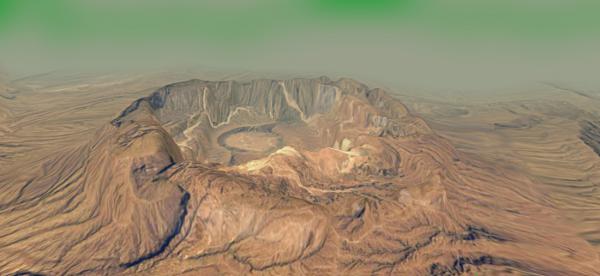BY LETTER
Mt. 'Thass'thon'
Supervolcano on To'ul'h Prime, important in local lore | |
 Image from Steve Bowers | |
| Mt Thass;thon (false colour radar image) | |
Mt. 'Thass'thon' (To'ul'hoss: summitless) is a supervolcano located in what is now northern Kh'ht in the continent of 'Tana'jan on To'ul'h Prime, home planet of the To'ul'h xenosophonts. Mt. 'Thass'thon' is perhaps the best-known caldera on the planet, and has been the subject of many myths and superstitions to nearby societies over the long history of To'ul'h civilisation. The supervolcano is also of importance to those studying the the history of the To'ul'hs - its eruption around 37,000 BT resulted in tens of millions of deaths worldwide, and bringing about a centuries-long hiatus to civilisation on Tohul. Historians often divide To'ul'h history into three epochs - Pre-Eruption (c. 72,500 BT - 37,500 BT), Post-Eruption (also called Pre-Contact, 37,500 BT - 4011 AT) and Post-Contact (4011 AT - present).
Legends and lore surrounding Mt 'Thass'thon'
As mentioned above, many civilisations on Tohul have held different religious beliefs regarding the nature and origin. of Mt. 'Thass'thon'. One of the most powerful societies of early Post-Eruption Tohul, he K'bakh'tho League (later Empire), for example, believed the volcano to be the dwelling place of the Five Hundred Twelve Gods of K'bakh'tho 1. The placing of gods on a mountaintop was particularly unusual on Tohul, due to the association of the upper skylands with Hell, however, the K'bakh'thos believed that the unbearable temperatures of the upper sky acted as a blanket, intended to prevent the unworthy from attempting to climb the great mount.A later society, the H'faah'lahn Kingdom, believed the island to have been created when two brothers, Tol'no and 'Ba, attempted to impress Aldas'tha, the goddess of love. 'Ba created many wide rivers and great lakes, while Tol'no created tall mountains, including 'Thass'thon, which grew so tall that it impaled the child of the terrifying sky god, 'Landa. 'Landa, enraged, brought 'Ba (who he mistakenly believed to be the creator of the great mount) to his home realm for eternal torment, while Tol'no, the true maker of 'Thass'thon, took Aldas'tha's hand in marriage. Other societies have believed 'Thass'thon to be the afterlife for sinners (most notably the Empire of the Unending Dynasty 2 ), while others have interpreted it as a source of negative energy (such as the 'Nal', who thought the mountain not only to be sapient, but the sister of the Mother Abyss, and source of all evil in the world 3). Shol'nath, a historian of the First World State and Keeper of the Library at the the Isle of 'Thisha, once humorously remarked that "(...) that cursed mountain is so shrouded in myth that one would not know whether to pray to it, run from it, or attempt to eat it".
 Image from Tasp | |
| an evening view of the mountain from the air , taken by drone | |
Around 37,500 years BT, the supervolcano erupted, in the most powerful eruption in the history of the To'ul'h species. The 'Thass'thon' Supereruption is considered by historians to be the most destructive event in the history of To'ul'h civilisation 5, resulting in a cooling period which lasted centuries, affecting crops and livestock, and causing mass famine among To'ul'h societies. The To'ul'hs were not the only ones affected, however - several species (including the famous basket-mouth skywhale) are known to have recovered from very low populations around the time of the eruption, and at least one major skyplankton subspecies is known to have gone extinct due to the 'Thass'thon' event, along with several floaters and skyfish. One species of the tho'rahl'shothan landsponge (a popular drug among To'ul'hs) is also known to have died out following the eruption. The Post-Eruption (or Pre-Contact) Epoch saw the development of many well-known To'ul'h ideas, including the To'ul'hoss language, and the 'Ha'ts'ul (To'ul'h Calendar). Along with the Lake Tso'hal Eruption, the 'Thass'thon' Eruption is the best known supereruption in Tohul history.
Footnotes
1: One of many noted similarities between the ancient Greeks and the K'bakh'tho League was the placement of deities atop a major mountain↩2: The Empire of the Unending Dynasty believed in several Hells for different classes of sinners, each of which was located on a major mountaintop.↩
3: It was often said that the many children of 'Thass'thon' resides at her summit, would attack To'ul'h not in their homes at night.↩
4: An important member of the K'bakh'tho League, a loose confederation of city-states located in Kh'ht, ultimately destroyed by the First Merciless Plague. Notably, Hath'jo preferred to be identified as "the Younger" in honor of his father, who, despite being of little historic note, was always regarded as his son's hero.↩
5: Though not the species - see the First Plague for details↩
Related Articles
Appears in Topics
Development Notes
Text by James Rogers
Initially published on 29 June 2016.
Image by Tasp added March 6, 2025
Initially published on 29 June 2016.
Image by Tasp added March 6, 2025






